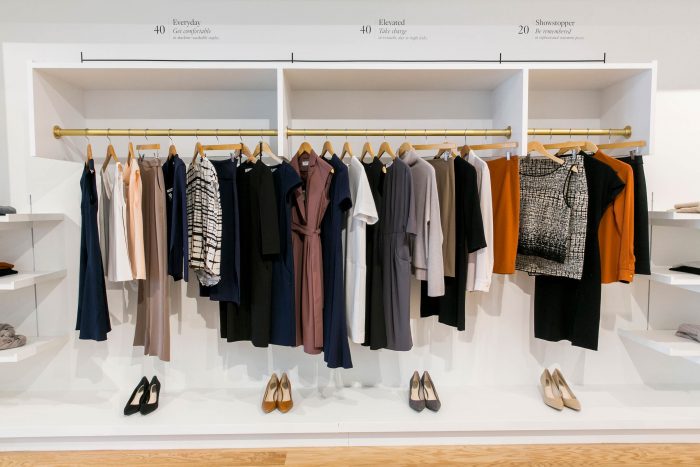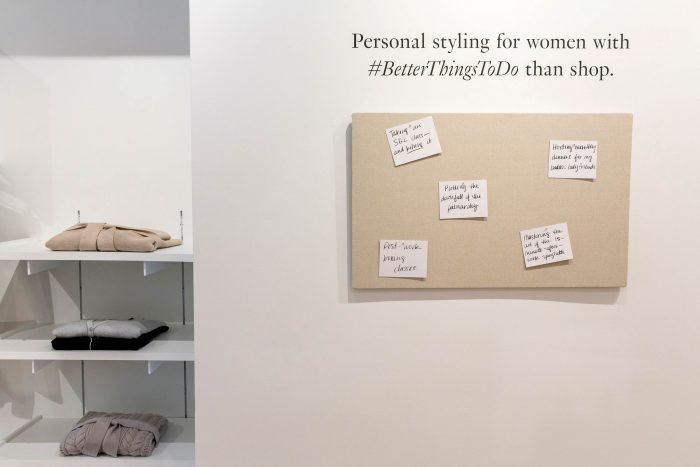The professional womenswear line takes the stress out of dressing for work.

MM.LaFleur chose K St. as the location for its second permanent showroom (Courtesy Photo)
“I don’t want to make decisions about what I’m eating or wearing. Because I have too many other decisions to make,” former president Barack Obama told Vanity Fair.
MM.LaFleur founder Sarah LaFleur repeats this quote in her book, “Wear to Work.” Like Obama’s choice for a pared-down wardrobe of gray and blue suits, LaFleur thinks women shouldn’t have to think too much about what they’re wearing to work every day. They have “better things to do” she says, which has become the company’s motto.
A struggle to find high-quality business attire at a mid-range price led the former management consultant to leave her private equity job in 2011 to launch a clothing line focused solely on workwear. With $35,000 saved plus a $35,000 loan from her parents, LaFleur hit the ground running, hiring former Zac Posen head designer Miyako Nakamura as creative director and coming up with seven dresses that were perfect for the workplace. MM.LaFleur launched online in 2013, opened its first brick-and-mortar store in New York in 2016 and just recently opened a Washington location. Thanks in part to a wildly popular e-commerce site (that includes online stylists and a “Bento Box” service that ships 4-6 items to customers, allowing them to keep what they love and send the rest back), MM. LaFleur is now up to 170 employees, with an estimated 300 percent revenue growth annually.

Sarah LaFleur (Courtesy Photo)
We caught up with LaFleur at her elegant K Street showroom to hear just why her company is so successful.
Washington Life: What made you decide on Miyako Nakamura as your designer?
Sarah LaFleur: We clicked. It certainly helped that she’s Japanese and I’m half Japanese. There was a bond but more than that, her aesthetic felt right. She had never done workwear and knew nothing about it. I was like, “Don’t you know these girls who walk to work in their flip flops or flats and then take our their heels when they get to work?
” And she was like, “No, I don’t know anybody like that.” But she got it really quickly. We went on our first trip to J. Crew together. I showed her the best selling cardigan, and she was like, “really?” It took her time to get her to understand the customer. I would organize focus groups and get forty women, like bankers, lawyers, and lobbyists, and they would tell her about their lifestyle.
WL: How would you describe your typical customer?
SL: In the beginning, we had lawyers, bankers, and consultants, positions you usually think of with working women. But we’ve branched out quite a bit. We have a lot of women in media now. Healthcare is one of the fastest growing customer groups. Age-wise, we’ve expanded a lot. We used to narrowly 25-35, but the 30-65 age range has grown a lot. What you’re wearing on the weekend, whether you’re 30 or 65, is going to be quite different, but what you’re wearing to the office isn’t all that different. I can’t think of any other brand where a daughter and mother can go into a shop and try the same kind of clothes. We also have a lot of working moms who are looking for “a playground dress,” as one customer put it, a dress she can wear to wear to the playground, to work, and then to a cocktail party. It’s a tall order, but we have a lot of pieces that can do that in our summer collection.
WL: What else will we see in your summer collection?
SL: Our spring collection was a little more buttoned up, and with summer we’re relaxing a bit. We’re playing with French terry, cotton viscose pieces, things that are little easier, and playground-to-workplace friendly.

Customers write notes of their #BetterThingsToDo (Courtesy Photo)
WL: What fabrics do you typically use for your dresses to make them long-lasting and machine washable?
SL: We do a lot of triacetate. It’s machine-washable and has the look of a very expensive fabric, but easy to take care of, as opposed to something like silk, for example. We’ve also done a lot of merino wool lately that we launched in the fall, but we’ve decided we want it as a permanent part of the collection. It’s a year-round fabric even though it’s wool. It’s machine-washable too, which people are really surprised about. The wool comes from grass-fed Australian sheep.
WL: What struggles do women have when they’re trying to find the right workwear and what mistakes do they make?
SL: They do a lot of panic shopping. You wake up on Monday morning and have a meeting but your clothes are at the dry cleaner, so you rush into the one store that’s open at 8 a.m. and are willing to spend any amount of money for a cardigan to throw over your dress. The result is you end up accumulating a lot of stuff you don’t really love. You should think of your clothing as an investment, so bring a little planning into it. Rather than running in and dropping $100 on something, save up for three months, and invest that money into something you like.

Inside the Washington showroom (Courtesy Photo)
WL: Do you have any tips for women just starting to build their work wardrobes?
SL: We advocate the idea of creating your own uniform; you can read more about that in “Wear to Work.” We say the perfect work wardrobe is a ratio of 40% everyday super easy pieces, 40% elevated pieces and 20% showstoppers. Think of value as price per wear. If you think about the lifetime spend that women put into clothing, it can be as much as you spend on a car, around $15,000 over five years. You should be strategic about your clothing, like you are with buying a car. We don’t want people buying our dresses, wearing them once, and them throwing them out. We design carefully, source carefully, and manufacture them carefully because we want women to wear dresses for 3, 5, 10 years. Our price-point is not super high, not super low, but in the middle. We think it’s justified because you’re going to get a ton of wear from these clothes.
We’re not saying it’s cheap, but it’s excellent value. It’s the direct-to-customer business model which the Internet has allowed us to capitalize on.
WL: Your website is impressive, from the Bento Box to an online magazine. What do you provide with your digital magazine, The M Dash?
SL: We wanted to create a conversation around professional women. In Japanese fashion magazines, models pose as professional women, pretending to go to work. As a little girl, I thought it was fun to dress up for work, and I was so shocked to come to the US and see that the covers weren’t of professional women. We’re trying to make professional women something to aspire towards. It’s a great time to be a working woman, and there’s a lot more to accomplish still, but there’s a lot to celebrate. Rather than saying we need to lean in more and do this and that, we should talk about that lifestyle. Martha Stewart made being a stay-at-home mom cool, but who’s doing that for professional women?
WL: What do you think of DC style?
SL: Everyone’s like “DC women need you,” and I was like, “That is so offensive to DC women.” DC’s a more conservative work environment.
DC women have to work under so many rules, even unspoken rules also. Sometimes you have to wear a jacket, or you need to wear a cardigan. There’s a grey zone, and it’s kind of blurry. There are not many brands that cater to that woman exclusively. Contemporary brands branch into that as an extension of what they’re doing, but it’s not their area of focus.
The contemporary brands that most women are shopping in, that’s not where they’re spending their design resources. We spend 100% of our resources on workwear, so that’s why I’m hoping we become the go-to for women in DC who have to dress a certain way.
WL: Do you have any advice for aspiring women entrepreneurs?
SL: Stop over-preparing. I think women have a tendency to have all their ducks in a row and then go do something. What I hear from entrepreneurs is that they need to save up money, so they’ll work a little bit more and then go do their thing. If you save whatever amount of money you have, as soon as you leave that job and start working at your startup, your finances will start dwindling and you’ll go into panic mode. It’s more important you have flexibility in your schedule, so find a side gig, like being a barista, bartender, tutor, or dog walker, and then just go for it.
Visit MM.LaFleur’s D.C. showroom at 1424 K St. NW.




